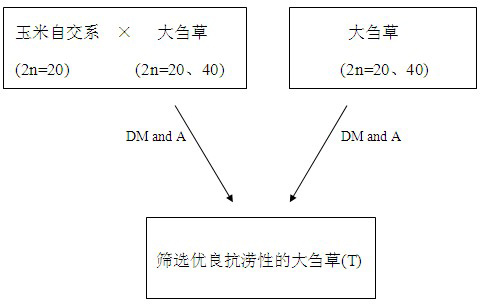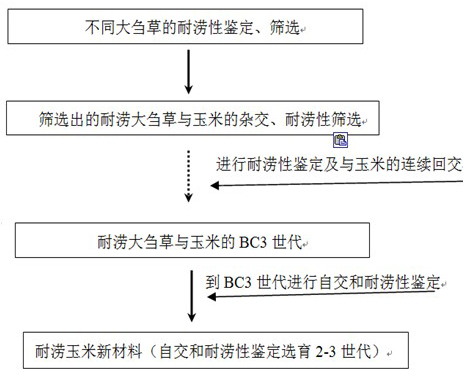Method for breeding novel waterlogging-tolerant maize variety by using special waterlogging tolerance of teosinte
A teosinte and corn technology, which is applied in the field of breeding new waterlogging-tolerant corn materials using the special waterlogging-resistant traits of teosinte, can solve the problems of high cost, limited effect of waterlogging prevention measures, and difficulty in implementing them, so as to shorten the breeding time, The effect of broadening maize germplasm
- Summary
- Abstract
- Description
- Claims
- Application Information
AI Technical Summary
Problems solved by technology
Method used
Image
Examples
Embodiment 1
[0022] In March 2007, we used Teosinte grass with high waterlogging resistance and selected Nicaragua maize species as the non-recurrent parent (male parent), and crossed the inbred line R08 as the recurrent parent (female parent), and harvested F 1 substitute seeds;
[0023] Planted F in March 2008 1 Generation, and backcross with R08 (female parent), harvested BC 1 f 1 substitute seeds;
[0024] Planted BC in March 2009 1 f 1 Generation of 600 grains, flooding for 14 days at the three-leaf one-heart stage, screened to obtain individual plants with high waterlogging resistance, transplanted into the field, after the plants tasseled, removed the intermediate and wild-type plants, and used the corn-type individual plants It is the male parent and R08 backcross, and the corresponding numbers are harvested as BC by individual plants. 1 f 2 Generation Seed and BC 2 f 1 substitute seeds;
[0025] Planted BC in September 2009 1 f 2 Generation Seed and BC 2 f 1 Substitu...
Embodiment 2
[0029] In 2007, the diploid perennial Teosinte grass with high waterlogging resistance was selected as the non-recurrent parent (male parent), and the inbred line Mo17 was used as the recurrent parent (female parent) for crossbreeding, and F 1 substitute seeds;
[0030] Planted F in March 2008 1 Generation, and backcross with Mo17 (female parent), harvested BC 1 f 1 substitute seeds;
[0031] Planted BC in March 2009 1 f 1 Generation of 600 grains, flooded for 14 days at the three-leaf one-heart stage, screened to obtain individual plants with high waterlogging resistance, transplanted into the field, after the plants tasseled, removed the intermediate type and wild type plants, and used the corn type The male parent is backcrossed with Mo17, corresponding to the serial number, and BC is harvested by individual plant 1 f 2 Generation Seed and BC 2 f 1 substitute seeds;
[0032] Planted BC in October 2009 1 f 2 Generation Seed and BC 2 f 1Substitute seeds were flo...
Embodiment 3
[0036] In March 2007, the local high-adaptability maize inbred line 48-2 (relatively higher waterlogging resistance) was selected as the non-recurrent parent (male parent), and the inbred line Mo17 (relatively lower waterlogging resistance) was selected as the recurrent parent (female parent). This) was crossed and harvested into F 1 substitute seeds;
[0037] Planted F in March 2008 1 Generation, and backcross with Mo17 (female parent) to obtain BC 1 f 1 Generation seeds, and selfing to obtain F 2 substitute seeds;
[0038] Planted BC in March 2009 1 f 1 Generation Seed and F 2 Substitute seeds were flooded for 14 days at the three-leaf-one-heart stage. According to the screening criteria in Example 1 and Example 2, no single plant with high waterlogging resistance was obtained.
PUM
 Login to View More
Login to View More Abstract
Description
Claims
Application Information
 Login to View More
Login to View More - R&D
- Intellectual Property
- Life Sciences
- Materials
- Tech Scout
- Unparalleled Data Quality
- Higher Quality Content
- 60% Fewer Hallucinations
Browse by: Latest US Patents, China's latest patents, Technical Efficacy Thesaurus, Application Domain, Technology Topic, Popular Technical Reports.
© 2025 PatSnap. All rights reserved.Legal|Privacy policy|Modern Slavery Act Transparency Statement|Sitemap|About US| Contact US: help@patsnap.com



